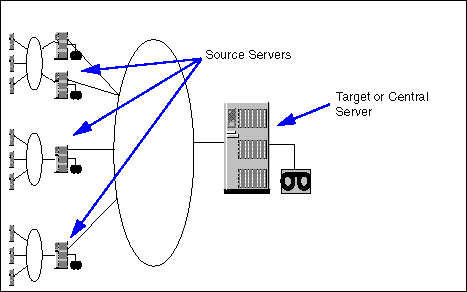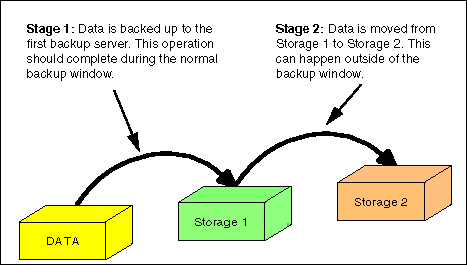 |

 IBM-AUSTRIA - PC-HW-Support 30 Aug 1999
IBM-AUSTRIA - PC-HW-Support 30 Aug 1999 |
Two-Tier Model
Two-Tier Model
As discussed in
Single Server Model
scalability and network bandwidth are limited when working with a
single server site. In a two-tier model, an intermediate backup server
is used as a staging platform (see Figure 6). The advantages
are twofold:
- The backup is done to the first backup server (or source
server), which resides locally (and has a LAN connection), and only then
forwarded to the central backup server (or target server). This can be
done asynchronously, so that communication performance between the first
and second-level backup servers is not critical.
- The backup completes
in a much shorter time as data transmission is not slowed down by tape
drive write speeds. This leads to much shorter backup windows.
You could also load balance large sites by adding additional source servers.

Figure 6. Two Tier Model
Figure 7 shows what happens with the
data that needs to be backed up. In the first stage, data is moved to
the source server. This happens during the period of time that we have
to take our backups (referred to as backup window; see
Scheduling Backups).

Figure 7. Data Movement in a Two-Tier Model
The specifications of the storage device connected to this source server
should be sufficient to store all the data that is backed up. Typically,
it will also be a fast device (probably a disk drive). In the second
stage, data on this storage device is moved across the network to a
second backup server. This normally happens after stage 1 completes (but
not necessarily, however), and can be done outside of the
normal backup window. The only rule here is that all data from the
source servers must be moved to the target server before the backup
window restarts.
This setup gives advantages with regard to scalability,
since you can add as many source servers as you want. However, more
intelligent software is required to manage the transfer of backed-up
data both in backup mode and in restore mode. In the case of a restore
operation, the user should not need to know on which backup server the
data is.
Another advantage of this server storage hierarchy is that in
case of a site disaster at the source server location, the backups still
reside on the target server. Of course, this advantage will only be true
if the target and source servers are geographically separated, and all
backup data has been moved to the central server.
Back to 
More INFORMATION / HELP is available at the IBM-HelpCenter
Please see the LEGAL - Trademark notice.
Feel free - send a  for any BUG on this page found - Thank you.
for any BUG on this page found - Thank you.


 for any BUG on this page found - Thank you.
for any BUG on this page found - Thank you.